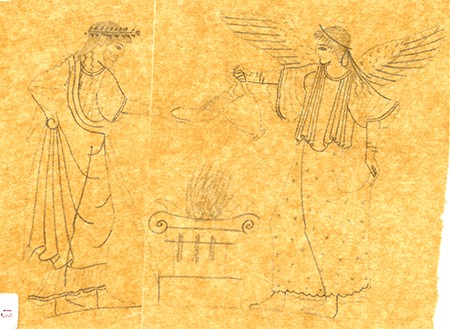The kerameikoi (potters’ quarters) dedicated to production of decorated vases in ancient Athens (600–400 BCE) are among the best-studied communities of practice in Greek and Roman classical archaeology. The rich imagery of the vases has served research in aspects of Greek culture from myths to daily life, religion, and gender, among others. Their level of craftsmanship made them highly desirable both at home and abroad, especially in Etruria. The rarity of potters’ signatures and the silence of ancient texts limit the amount of extant biographical information on Greek potters, especially in comparison to what we have for bronze sculptors and panel painters regarding their works, teachers, and pupils. Modern connoisseurship studies, mainly owing to Sir J. D. Beazley (1885–1970), professor at the University of Oxford, have established ties among potters and painters. Beazley, using a Morellian connoisseurship method devised for discerning the oeuvres of Renaissance painters, distinguished more than 1,200 Athenian “hands” on the basis of idiosyncratic renderings of figures (such as faces, hands, and feet) that are thought to capture the essential style of an artist. He incorporated his results and those of hiscontemporaries in two fundamental works: Attic Black-Figure Vase Painters (ABV; 1956) and the second edition of his Attic Red-Figure Vase Painters (ARV²; 1963).
At CASVA, I revisited Beazley’s connoisseurship studies in the context of attribution research in both Athenian and Renaissance art with three main goals in mind: to probe deeper into the long-standing practice of evaluating newly discovered Athenian vases or painters in relation to Renaissance art; to employ social network analysis (SNA) to convert Beazley’s connoisseurship ties into a more comprehensive, dynamic set of relationships; and to bring the complicated connections of apprenticeship, collaboration, or imitation into greater relief.
Beazley’s connoisseurship studies in Athenian vase painting served
as a model for detecting “hands” in a variety of cases, from Corinthian potters, to Cycladic marble figurine sculptors, to Mycenaean palatial scribes of Linear B clay tablets. According to Beazley’s reconstruction, the Athenian potters’ quarters were extremely complicated, densely populated with followers, imitators, brothers (in his terminology), and companions working together. He devised but never defined a long list of terms to denote the stylistic relationships based on these ties. In the 1990s this celebrated approach underwent intense criticism for the ethical dilemmas it created regarding inflated art market prices for “attributed” objects. A review of scholarship for Italian and Northern European connoisseurship studies, even as late as the 2000s, revealed how the same concerns and the same opacity of terminology remain thorny issues regardless of the cultural period in which they are deployed.
Beazley would sometimes use Renaissance regional affinities to differentiate the style of an Athenian painter: one painter was more Sienese, another more Florentine. Comparing Greek vases to Renaissance art can in fact be traced back to the volumes commissioned by Sir William Hamilton, British ambassador to Naples from 1764 to 1800, on his vase collection in advance of selling it to the British government. For two centuries, from Hamilton to Beazley, Athenian vases and Renaissance art shared an intimate relationship in the scholarly literature. The rare book collection of the National Gallery of Art Library allowed me to undertake a more profound study of these archival sources. The engravers for Hamilton’s volumes heavily distorted the decoration of Greek vase paintings, often divorcing them from the carrying pot, other times misplacing or omitting figures, and regularly adding extravagant decorative borders more appropriate for textiles than ceramics. This visual alteration was hardly surprising, as some of the engravers were employed in the manufacture of tapestries in Naples. Drawing parallels between newly discovered Greek art and Renaissance or later European painting guaranteed a swift and solid means of integration and validation of ancient Greek art in the canon of Western art.
Beazley’s connoisseurship ties for the Athenian vase painters, despite the criticism they have received, provide a good test case employing SNA. As part of a collaborative project, I combed through ABV to pair any type of connection (for example, collaboration, imitation, or apprenticeship), in a two-column format (called “edge list” in SNA terminology) and to render them through social networks software (NodeXL) in order to visualize the connections among more than 400 artists working in the black-figure technique in Athens from 600 to 400 BCE. Visualizing these ties from listings in a linear book format, with related entries often hundreds of pages apart, as Beazley himself lamented, is challenging. In addition, the current limitations of an otherwise valuable digital resource (Beazley Archive Pottery Database) for searching connections among artists corroborated the importance of undertaking a panoramic project of associations in which both central and peripheral actors would be readily noticeable.
Our analysis also highlighted how Beazley had closely associated artists with certain shapes. Half of the ABV chapters are constructed around vase shapes (such as amphorae, lekythoi, olpai, or drinking cups), matching in number his chapters centered on important personalities. The intensity of curvature, for instance, would have played a vital role in the training of painters who specialized in scenes of certain sizes and certain types of optical distortion. SNA will also be applied to Beazley’s tighter interconnections among painters working in the red-figure technique to compare collaboration patterns of black-figure painters to those of red-figure painters.
Ultimately, the connoisseurship-based SNA for the Athenian potters’ quarters can serve as a model for employing this method for mapping apprenticeship and collaboration ties as recounted in ancient encyclopedias, such as Pliny’s lists of sculptors and their pupils, or in artists’ lives, such as Vasari’s accounts of Renaissance apprenticeships and collaborations. With this last example, Greek vases could now serve as a model for Renaissance arts, reversing a time-honored hierarchy.
